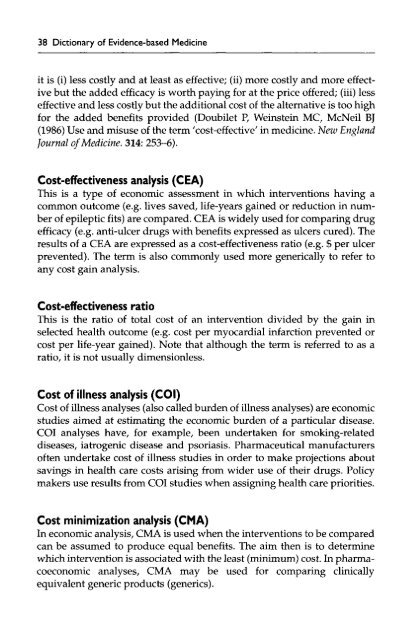Dictionary of Evidence-based Medicine.pdf
Dictionary of Evidence-based Medicine.pdf
Dictionary of Evidence-based Medicine.pdf
Create successful ePaper yourself
Turn your PDF publications into a flip-book with our unique Google optimized e-Paper software.
38 <strong>Dictionary</strong> <strong>of</strong> <strong>Evidence</strong>-<strong>based</strong> <strong>Medicine</strong><br />
it is (i) less costly and at least as effective; (ii) more costly and more effective<br />
but the added efficacy is worth paying for at the price <strong>of</strong>fered; (iii) less<br />
effective and less costly but the additional cost <strong>of</strong> the alternative is too high<br />
for the added benefits provided (Doubilet P, Weinstein MC, McNeil BJ<br />
(1986) Use and misuse <strong>of</strong> the term 'cost-effective' in medicine. New England<br />
Journal <strong>of</strong> <strong>Medicine</strong>. 314: 253-6).<br />
Cost-effectiveness analysis (CEA)<br />
This is a type <strong>of</strong> economic assessment in which interventions having a<br />
common outcome (e.g. lives saved, life-years gained or reduction in number<br />
<strong>of</strong> epileptic fits) are compared. CEA is widely used for comparing drug<br />
efficacy (e.g. anti-ulcer drugs with benefits expressed as ulcers cured). The<br />
results <strong>of</strong> a CEA are expressed as a cost-effectiveness ratio (e.g. $ per ulcer<br />
prevented). The term is also commonly used more generically to refer to<br />
any cost gain analysis.<br />
Cost-effectiveness ratio<br />
This is the ratio <strong>of</strong> total cost <strong>of</strong> an intervention divided by the gain in<br />
selected health outcome (e.g. cost per myocardial infarction prevented or<br />
cost per life-year gained). Note that although the term is referred to as a<br />
ratio, it is not usually dimensionless.<br />
Cost <strong>of</strong> illness analysis (COI)<br />
Cost <strong>of</strong> illness analyses (also called burden <strong>of</strong> illness analyses) are economic<br />
studies aimed at estimating the economic burden <strong>of</strong> a particular disease.<br />
COI analyses have, for example, been undertaken for smoking-related<br />
diseases, iatrogenic disease and psoriasis. Pharmaceutical manufacturers<br />
<strong>of</strong>ten undertake cost <strong>of</strong> illness studies in order to make projections about<br />
savings in health care costs arising from wider use <strong>of</strong> their drugs. Policy<br />
makers use results from COI studies when assigning health care priorities.<br />
Cost minimization analysis (CMA)<br />
In economic analysis, CMA is used when the interventions to be compared<br />
can be assumed to produce equal benefits. The aim then is to determine<br />
which intervention is associated with the least (minimum) cost. In pharmacoeconomic<br />
analyses, CMA may be used for comparing clinically<br />
equivalent generic products (generics).










